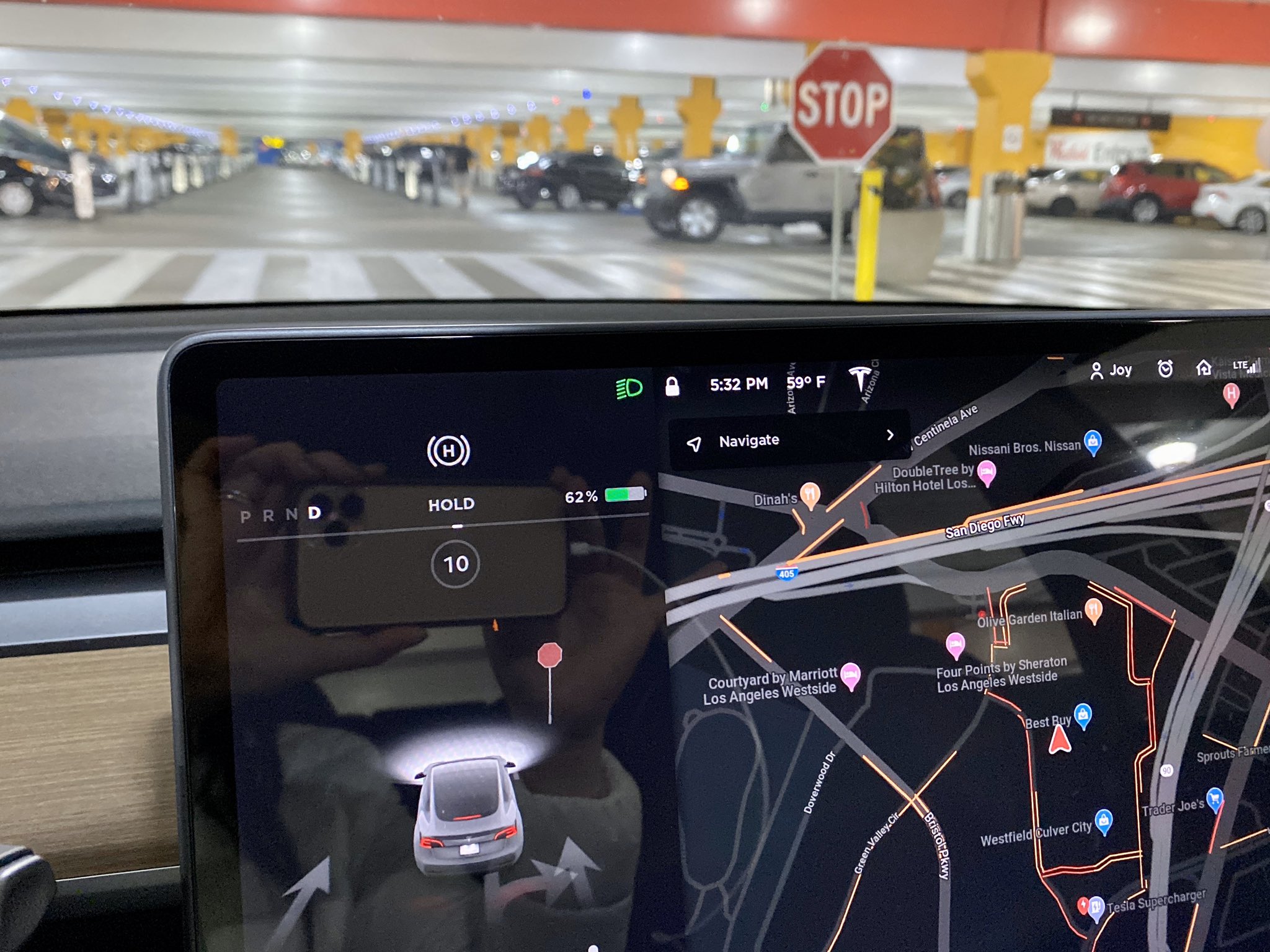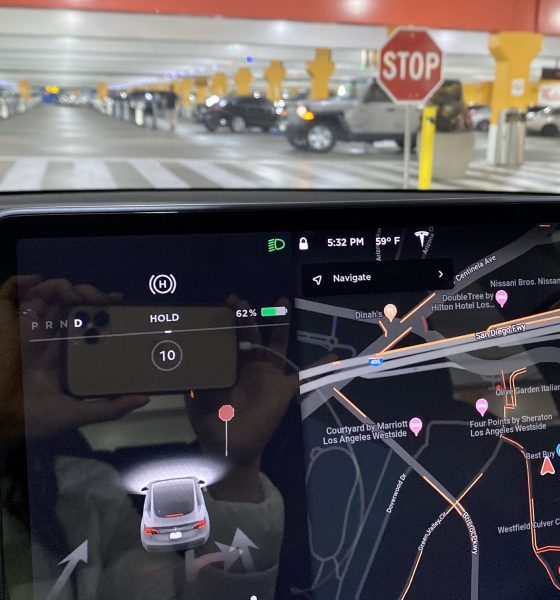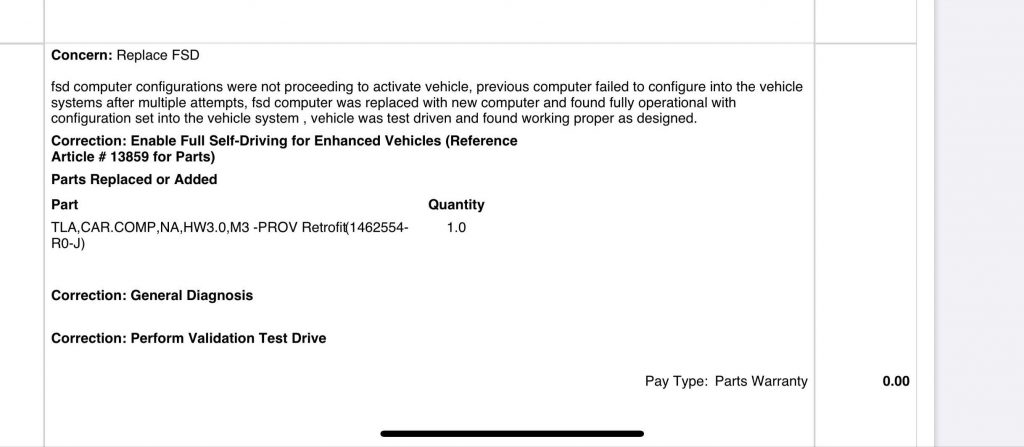

News
Tesla Model 3 gets Full Self-Driving HW3 upgrade: Full details with lessons learned
True to Elon Musk’s expectations on Twitter last month, it appears that Tesla is now looking to ramp Hardware 3 retrofits for owners who purchased the Full Self-Driving suite and whose cars are equipped with HW2 or HW2.5. A recent account involving a Tesla owner-enthusiast’s experience with her Model 3’s HW3 upgrade shows that there are still some areas in the retrofit process that can be improved.
Tesla Model 3 owner-enthusiast TeslaJoy was looking to do a video on the company’s recent voice command update when she noticed that the feature on her vehicle was not working properly. This prompted her to make an appointment with Tesla to get her car checked in and fixed. During the troubleshooting process, she inquired if a possible HW3 retrofit could be done to her vehicle as well. Fortunately, a HW3 unit was available for her Model 3, and so, a rather eventful upgrade process began.
Tesla Service Centers currently receive batches of HW3 units from the electric car maker, and each unit is assigned to a specific VIN. This is the reason why for now, at least, owners are not advised to call Tesla to schedule a HW3 retrofit. Fortunately for Joy, the Tesla Service Center opted to perform the HW3 upgrade at the same time as her appointment, since she would need to bring her Model 3 back for a retrofit anyway.

Since the retrofit was estimated to take around 5 hours, Tesla asked the Model 3 owner to leave her car for the day and claim it the next business day. That was December 31, which meant that the vehicle should be ready the day after New Year’s. As it would turn out, the Service Center would end up encountering difficulties installing the necessary firmware on Joy’s Model 3. This resulted in delays, which culminated in the vehicle’s HW3 retrofit being completed on January 5, 2020, over five days after the Model 3 owner turned in her car.
Hardware 3 retrofits are available for owners who have purchased Tesla’s Full Self-Driving suite, and whose cars are still equipped with the company’s HW2 and HW2.5 units. With Hardware 3 installed, owners will be able to utilize the full suite of FSD capabilities that the company is rolling out today. One of these is the FSD preview that Tesla rolled out for the holidays, as well as features like traffic cone recognition.
True to Elon Musk’s words on Twitter, the HW3 retrofit is free for owners who have purchased the company’s FSD suite. Joy, for her part, was able to get FSD last March at a discounted price of $2,000 on top of her Enhanced Autopilot. FSD currently costs $7,000 when it is included in a new vehicle’s order.
Based on Joy’s experience, it appears that owners should expect to wait some time for their vehicles are set to be retrofitted. In the Model 3 owner’s case, her car’s upgrade ended up taking days since the first HW3 kit that was installed did not function properly. This resulted in the vehicle essentially getting retrofitted twice, causing delays. Tesla did give Joy a $500 Uber voucher due to the absence of loaner vehicles, but the whole experience showed notable points for improvement nonetheless.
In a way, TeslaJoy‘s experience with her Model 3’s HW3 retrofit stands in stark contrast with the experiences of Model S owner Sofiaan Fraval, whose car was upgraded by a Service Center during a voluntary HEPA replacement. In Fraval’s case, his Model S was fully retrofitted within a matter of hours, and it was calibrated in pretty much the same day. A Tesla Model S owner who runs the Electric Dreams YouTube channel also received his vehicle’s HW3 retrofit without any issues, and it was performed by a mobile technician, not a Service Center.
In the Electric Dreams host’s case, the entire HW3 retrofit was conducted from the convenience of his home, with a mobile service tech coming over in the morning, taking an hour and a half for the installation to be completed, and an additional two hours for the necessary firmware to be loaded onto the vehicle. This is in line with Elon Musk’s previous statement on Twitter, where he stated that HW3 retrofits should be possible through Tesla’s mobile service fleet.
Overall, there seems to be a variance with regards to the experience of owners when getting their vehicles retrofitted with Tesla’s FSD computer. Some owners seem to be experiencing a seamless, painless process, while some, like Joy, end up having to test their patience. Hopefully, as Tesla ramps its HW3 retrofits this quarter, the company could work in optimizing its upgrade process, so there are more experiences like the Electric Dreams host’s, and less like TeslaJoy‘s.
Watch TeslaJoy‘s HW3 experience in the video below.

News
Tesla Model Y Standard Long Range RWD launches in Europe
The update was announced by Tesla Europe & Middle East in a post on its official social media account on X.

Tesla has expanded the Model Y lineup in Europe with the introduction of the Standard Long Range RWD variant, which offers an impressive 657 km of WLTP range.
The update was announced by Tesla Europe & Middle East in a post on its official social media account on X.
Model Y Standard Long Range RWD Details
Tesla Europe & Middle East highlighted some of the Model Y Standard Long Range RWD’s most notable specs, from its 657 km of WLTP range to its 2,118 liters of cargo volume. More importantly, Tesla also noted that the newly released variant only consumes 12.7 kWh per 100 km, making it the most efficient Model Y to date.
The Model Y Standard provides a lower entry point for consumers who wish to enter the Tesla ecosystem at the lowest possible price. While the Model 3 Standard is still more affordable, some consumers might prefer the Model Y Standard due to its larger size and crossover form factor. The fact that the Model Y Standard is equipped with Tesla’s AI4 computer also makes it ready for FSD’s eventual rollout to the region.
Top Gear’s Model Y Standard review
Top Gear‘s recent review of the Tesla Model Y Standard highlighted some of the vehicle’s most notable features, such as its impressive real-world range, stellar infotainment system, and spacious interior. As per the publication, the Model Y Standard still retains a lot of what makes Tesla’s vehicles well-rounded, even if it’s been equipped with a simplified interior.
Top Gear compared the Model Y Standard to its rivals in the same segment. “The introduction of the Standard trim brings the Model Y in line with the entry price of most of its closest competition. In fact, it’s actually cheaper than a Peugeot e-3008 and costs £5k less than an entry-level Audi Q4 e-tron. It also makes the Ford Mustang Mach-E look a little short with its higher entry price and worse range,” the publication wrote.
Elon Musk
Elon Musk’s xAI bets $20B on Mississippi with 2GW AI data center project
The project is expected to create hundreds of permanent jobs, dramatically expand xAI’s computing capacity, and further cement the Mid-South as a growing hub for AI infrastructure.

Elon Musk’s xAI plans to pour more than $20 billion into a massive new data center campus in Southaven, Mississippi, marking the largest single economic development project in the state’s history.
The project is expected to create hundreds of permanent jobs, dramatically expand xAI’s computing capacity, and further cement the Mid-South as a growing hub for AI infrastructure.
xAI goes MACROHARDRR in Mississippi
xAI has acquired and is retrofitting an existing facility in Southaven to serve as a new data center, which will be known as “MACROHARDRR.” The site sits near a recently acquired power plant and close to one of xAI’s existing data centers in Tennessee, creating a regional cluster designed to support large-scale AI training and inference.
Once completed, the Southaven facility is expected to push the company’s total computing capacity to nearly 2 GW, placing it among the most powerful AI compute installations globally. The data center is scheduled to begin operations in February 2026.
Gov. Tate Reeves shared his optimism about the project in a press release. “This record-shattering $20 billion investment is an amazing start to what is sure to be another incredible year for economic development in Mississippi. Today, Elon Musk is bringing xAI to DeSoto County, a project that will transform the region and bring amazing opportunities to its residents for generations. This is the largest economic development project in Mississippi’s history,” he said.
xAI’s broader AI ambitions
To secure the investment, the Mississippi Development Authority approved xAI for its Data Center Incentive program, which provides sales and use tax exemptions on eligible computing hardware and software. The City of Southaven and DeSoto County are also supporting the project through fee-in-lieu agreements aimed at accelerating development timelines and reducing upfront costs.
Founded in 2023 by Elon Musk, xAI develops advanced artificial intelligence systems focused on large-scale reasoning and generative applications. Its flagship product, Grok, is integrated with the social media platform X, alongside a growing suite of APIs for image generation, voice, and autonomous agents, including offerings tailored for government use.
Elon Musk highlighted xAi’s growth and momentum in a comment about the matter. “xAI is scaling at an immeasurable pace — we are building our third massive data center in the greater Memphis area. MACROHARDRR pushes our Colossus training compute to ~2GW – by far the most powerful AI system on Earth. This is insane execution speed by xAI and the state of Mississippi. We are grateful to Governor Reeves for his support of building xAI at warp speed,” Musk said.
Elon Musk
Tesla AI Head says future FSD feature has already partially shipped

Tesla’s Head of AI, Ashok Elluswamy, says that something that was expected with version 14.3 of the company’s Full Self-Driving platform has already partially shipped with the current build of version 14.2.
Tesla and CEO Elon Musk have teased on several occasions that reasoning will be a big piece of future Full Self-Driving builds, helping bring forth the “sentient” narrative that the company has pushed for these more advanced FSD versions.
Back in October on the Q3 Earnings Call, Musk said:
“With reasoning, it’s literally going to think about which parking spot to pick. It’ll drop you off at the entrance of the store, then go find a parking spot. It’s going to spot empty spots much better than a human. It’s going to use reasoning to solve things.”
Musk said in the same month:
“By v14.3, your car will feel like it is sentient.”
Amazingly, Tesla Full Self-Driving v14.2.2.2, which is the most recent iteration released, is very close to this sentient feeling. However, there are more things that need to be improved, and logic appears to be in the future plans to help with decision-making in general, alongside other refinements and features.
On Thursday evening, Elluswamy revealed that some of the reasoning features have already been rolled out, confirming that it has been added to navigation route changes during construction, as well as with parking options.
He added that “more and more reasoning will ship in Q1.”
🚨 Tesla’s Ashok Elluswamy reveals Nav decisions when encountering construction and parking options contain “some elements of reasoning”
More uses of reasoning will be shipped later this quarter, a big tidbit of info as we wait v14.3 https://t.co/jty8llgsKM
— TESLARATI (@Teslarati) January 9, 2026
Interestingly, parking improvements were hinted at being added in the initial rollout of v14.2 several months ago. These had not rolled out to vehicles quite yet, as they were listed under the future improvements portion of the release notes, but it appears things have already started to make their way to cars in a limited fashion.
Tesla Full Self-Driving v14.2 – Full Review, the Good and the Bad
As reasoning is more involved in more of the Full Self-Driving suite, it is likely we will see cars make better decisions in terms of routing and navigation, which is a big complaint of many owners (including me).
Additionally, the operation as a whole should be smoother and more comfortable to owners, which is hard to believe considering how good it is already. Nevertheless, there are absolutely improvements that need to be made before Tesla can introduce completely unsupervised FSD.








